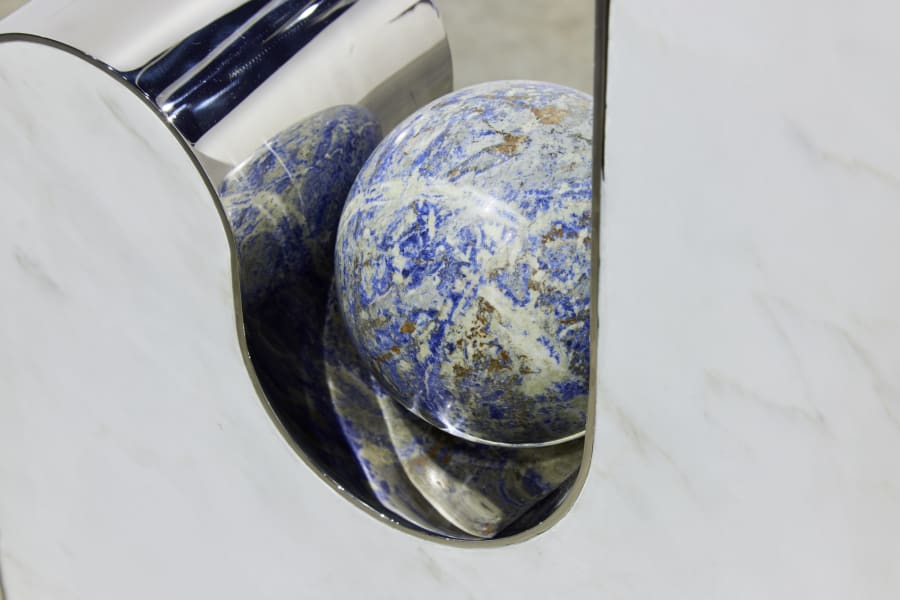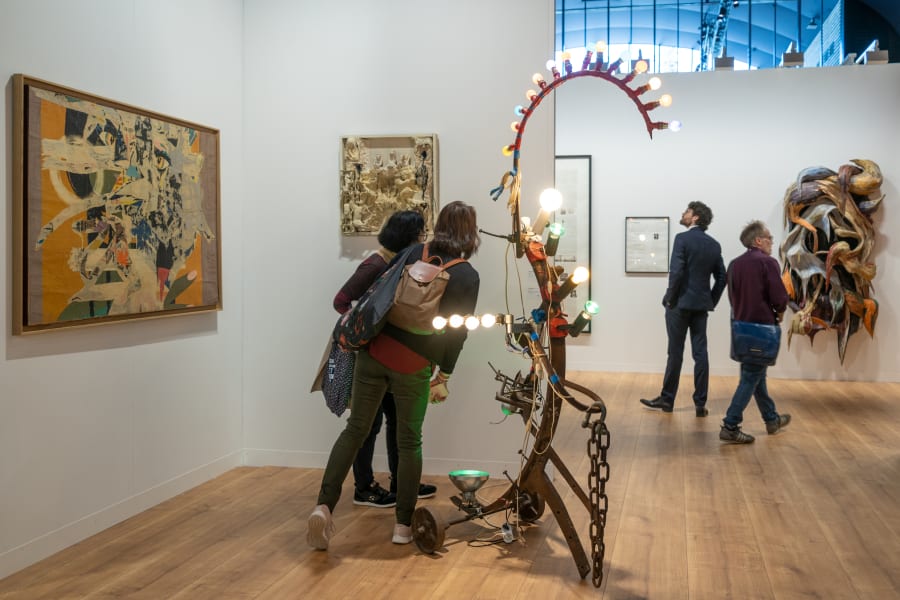What if wearing a housecoat was the ultimate recipe for art market success? One might be tempted to ask the question when looking at Gustav Klimt’s Dame mit Fächer (Lady with a Fan) (1917-18) and Max Beckmann’s Selbstbildnis gelb-rosa (Self-Portrait Yellow-Pink) (1943), two paintings that reached record prices in recent years.
The Austrian master’s portrait of a young woman, a luxurious robe negligently cascading down her shoulder, fetched USD 108.4 million at Sotheby’s in the summer of 2023, making it the second most expensive work sold at auction globally that year. German artist Max Beckmann’s self-portrait, in which he gazes melancholically beyond the frame wearing a yellow peignoir, went for USD 24.4 million at Berlin’s Grisebach in December 2022. This is, to date, the highest price achieved for a painting sold at auction in Germany.
But whatever the garment worn, the Impressionist, Post-Impressionist, and Modern markets have not been on the ascent. According to The Art Basel and UBS Global Art Market Report 2024, the value of Modern art sold at auction has fallen by 30% over the past 10 years, totaling USD 3 billion in 2023. The Impressionist and Post-Impressionist market (defined for the purposes of the market report as artists born between 1821 and 1874, which includes Klimt) has fluctuated over the same period of time; however, it dropped by 35% in 2023, from USD 2.6 billion to USD 1.7 billion, slightly below its 2013 value. Paradoxically, the impressive results achieved by top lots in these markets illustrate the main challenge they face: the scarcity of top grade material. ‘Over the past 5 to 10 years, we have noticed increased attention for the most sought-after [Modern] works, with less dynamism around secondary lots,’ says Dr. Markus Krause, a director and partner at Grisebach auction house.
Klimt and Beckmann are emblematic of the movements they belonged to – the Vienna Secession for the former, New Objectivity for the latter. Both sought to disrupt an established art historical canon in the countries from which they emerged (Austria-Hungary and Germany) and reflect broader developments in society and culture. Beckmann’s post-World War I Germany was plagued by economic uncertainty, political instability, and ideological disillusion; New Objectivity aimed to showcase this tumultuous reality in frank terms, at odds with the colorful scenes popularized by Expressionism a decade earlier. Artists such as Otto Dix, George Grosz, Lotte Laserstein, and Jeanne Mammen created works depicting sex workers, war veterans, Queer cabaret performers, and their peers with unflinching directness.
This, however, had dire consequences: When Adolf Hitler and the Nazis came to power, they declared New Objectivity ‘degenerate art’ (they applied the same label to Expressionism, the Vienna Secession, and many other art movements). Beckmann and his contemporaries were persecuted and many of their works destroyed. Krause explains that the leftist politics embraced by many New Objectivity artists made them priority targets. As a consequence, he estimates that it is currently easier to find Expressionist works on the market than material associated with New Objectivity. (The Nazis were much more eager to preserve Klimt’s paintings, which they looted and sold, or kept for themselves.)
Who are the private collectors interested in these rare finds? Jörg Maass, a Berlin-based art dealer specializing in German art of the early 20th century, says they are mostly older and European or American. Despite its somewhat short reach, Maass notes that the market for New Objectivity has remained rather stable – and interesting for collectors with relatively humbler means. ‘As an anticyclical area, the opportunities are many – one just needs to pick an artist and be advised well.’ Krause agrees: ‘It is a connoisseur’s market, really,’ he says. ‘You can get something very special for a reasonable price, compared with Expressionism, for example.’
Formal aspects may have played a role in keeping the market rather cool too. With its often bleak, graphic motifs and muted palettes, works made by New Objectivity artists can be more difficult to gush about at first glance than Klimt’s exuberant colors and elegant women or Ernst Ludwig Kirchner’s vibrant landscapes. If Berlin’s main airport chose to promote Otto Dix as much as Vienna’s promotes Klimt, it might start to look a bit scary. What’s more, New Objectivity does not have a single representative that strongly outshines their peers in the public eye or on the market. By comparison, Klimt’s crushing fame and success have made him the overwhelming object of desire among Secession artists. Oskar Kokoschka and Egon Schiele, Viennese contemporaries of Klimt, have also found notable success on the market, albeit to a far lesser extent.
In Berlin, a group of collectors nevertheless decided to lobby for one particular New Objectivity artist. Founded in 2022, Das Kleine Grosz Museum is dedicated to the work of George Grosz, one of the movement’s most important protagonists. The museum is located in a 1950s former gas station in the west of the German capital, which used to be the private home of Juerg Judin, a Swiss gallerist and collector who owns dozens of works by the German artist. ‘It is most definitely one of the world’s leading private collections of works by Grosz, both in terms of quality and quantity,’ says Dr. Pay Matthis Karstens, the museum’s second chairman. Karstens explains that Das Kleine Grosz Museum was founded upon the initiative of Ralph Jentsch, the managing director of the Grosz estate. In somewhat typical German fashion, interested collectors and art historians formed a verein – a highly common form of non-profit association – to bring the project to life.
While discussions with the Berlin government have been ongoing, they have not yet resulted in a commitment to create a dedicated, public framework to display Grosz’s oeuvre. ‘The space is temporary and was always aimed at showing what’s possible,’ Karstens says. In this sense, the private museum functions as a materialized argument to convince a government that an artist deserves more public recognition – a model that highlights the passion and belief that often characterize collectors specialized in a restricted field.
It also shows how relevant institutional recognition and academic guarantees are for the Modern market. Provenance, for example, is a factor the market for contemporary art does not have to contend with nearly as much. Krause, Maass, and Karstens all insist on its crucial role. ‘Each artwork we receive is thoroughly vetted by a dedicated team of four people,’ Krause says. ‘The huge progress achieved by provenance research over the past years also enables us to discover more and more surprising things about the artworks we put to auction, and all our catalogs are counterchecked by the Art Loss Register,’ he adds. Dealer Jörg Maass also states that he regularly collaborates with researchers and provenance experts to ensure as much transparency as possible. Maass and Krause agree that these processes ensure that collectors do not become hesitant when considering a work for purchase. Nevertheless, they represent a substantial investment of resources.
Despite this uneven terrain, there are some green shoots on the horizon. Scarcity will remain a challenge, but what Maass describes as ‘an admirable evenness in quality’ may be this important art movement’s main advantage, alongside an attractive price point. Indeed, when looking at lots featured in Grisebach’s upcoming Modern auction, works by Dix, Mammen, Franz Radziwill, and Conrad Felixmüller all exude a similar sense of compelling vigor. In addition, the upcoming centenary of the 1925 Kunsthalle Mannheim exhibition that gave the movement its name – ‘Die Neue Sachlichkeit. Deutsche Malerei seit dem Expressionismus’ (‘New Objectivity. German Painting since Expressionism’) – will renew the public’s interest, Krause and Karstens believe. Lastly, the parallels between our times and those depicted by Beckmann, Dix, and their cohorts are uncanny: a society striving for more progressiveness concurrently facing economic uncertainty, inflation, geopolitical conflict, and fascism rearing its ugly head. The directness with which New Objectivity artists confronted these developments feels more vital and necessary than ever, and their prescient point of view deserves more attention – both from the general public and the market.
Download the Art Basel and UBS Art Market Report 2024 here
Karim Crippa is Art Basel's Senior Editor and Paris+ par Art Basel's Head of Communications.


